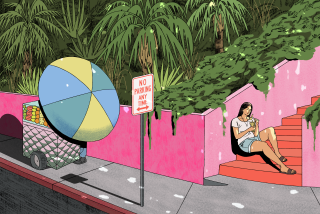Opera Opening Segues to an Aria for L.A.
- Share via
We went to the opening of the Music Center Opera the other evening, and I had to revise my notions about cities having peaked in earlier times.
About two of them, at least: Los Angeles and Paris.
I have written that Paris peaked in the first decade of the present century--La Belle Epoque--and Los Angeles peaked in the 1930s, after its golden age of architecture.
The opera was Puccini’s “La Boheme,” and the curtain rose on a set so bleak, so cold, so barren, that I could feel the coldness and poverty of 19th-Century Paris.
The Bohemian friends Marcello and Rodolpho are painting and writing in their garret, which is represented by an open platform in a small Parisian square. The narrow three-story French buildings with their Mansard roofs are closed and cold. In the center of the garret stands a gigantic stove--two feet taller than the men. It is obviously the most important piece of furniture, a symbol of the Bohemians’ constant struggle to stay warm. (In his review Martin Bernheimer described it as “huge, cylindrical, quintessentially phallic.”)
There is no wood to feed the fire. Marcello, the artist, offers to throw in his painting of the Red Sea, but they are afraid the burning paint will smell. Rodolpho throws in the pages of his manuscript. Art is sacrificed to the furnace.
“The drama has ended,” cries the despairing Rodolpho. “So has the fire.”
When Rodolpho is alone the frail but delectable neighbor, Mimi, enters through the trap door. Her candle has gone out--a reminder that her room had no electricity, and probably no gas. Conveniently, she has also lost her key. They are warmed by instant love.
Mimi speaks sweetly of herself: “I embroider flowers for a living. I live alone in a little garret, but from my window I see the sky.”
We see that her only treasure is that patch of sunlight, which, in a Paris winter, must be as rare as manuscripts to burn.
We go into the streets, where a motley crowd is warmed by rags. Snow falls. There is no light in the windows of the shops. The trees are bare. Snow piles up on the benches.
In the fourth act the consumptive Mimi expires on a mattress whose bed frame has either been sold or consumed by the stove. Too late, the philosophic Colline offers to sell his coat to buy Mimi medicine, and the flirtatious Musetta offers to sell her earrings to buy her mittens.
In his grief Rodolpho speaks of “no more shared awakenings.” I can think of no experience more warming than a shared awakening.
La Belle Epoque was 70 years later than the Paris of “La Boheme,” but Parisian winters were doubtless cold enough to freeze a jeune fille’s kneecaps, even in that enlightened age.
In “Swann’s Way,” Marcel Proust’s narrator writes of walking with Francoise to the Pont de la Concorde to see the Seine frozen over, and back to the Champs-Elysees where the paths cleared of snow appeared black, and a statue held “a long pendant icicle in its hand.”
Poverty, sickness, cold and death. That was 19th-Century Paris.
The first-night audience was splendidly and warmly attired, many of the women in long dresses, fur wraps and jewels; the men in tuxedos. It was a much larger and surely a glitzier crowd than the one that left the Los Angeles Theater one-third empty for the first American performance of “La Boheme” on Oct. 14, 1897.
Those invited to the gala post-curtain party walked across Hope Street to the terrace of the Department of Water and Power Building, which had been decorated like the Cafe Momus of “La Boheme.” The crowd danced and glittered. The catered dinner was superb. Wine flowed. The weather was balmy. The department had turned on its fountains for the occasion. They gushed like plumes of orange juice. A French trio played such pop favorites as “I Love Paris,” “Pigalle,” and that piece of meteorological chicanery, “April in Paris.”
A few blocks to the south half a dozen of the city’s new banking towers soared in peach-colored splendor, symbolic of the city’s spectacular rise as the financial center of the Pacific Rim. Los Angeles, for the moment, seemed to have peaked again.
Maybe we still have a chance.
All we have to do is clean our air, dispose of our garbage, curb crime, pay our schoolteachers and librarians more, eliminate prejudice, cool our tempers, eliminate poverty and elect Rep. Pat Schroeder (D-Colo.) President.
Is that impossible?
More to Read
The biggest entertainment stories
Get our big stories about Hollywood, film, television, music, arts, culture and more right in your inbox as soon as they publish.
You may occasionally receive promotional content from the Los Angeles Times.










